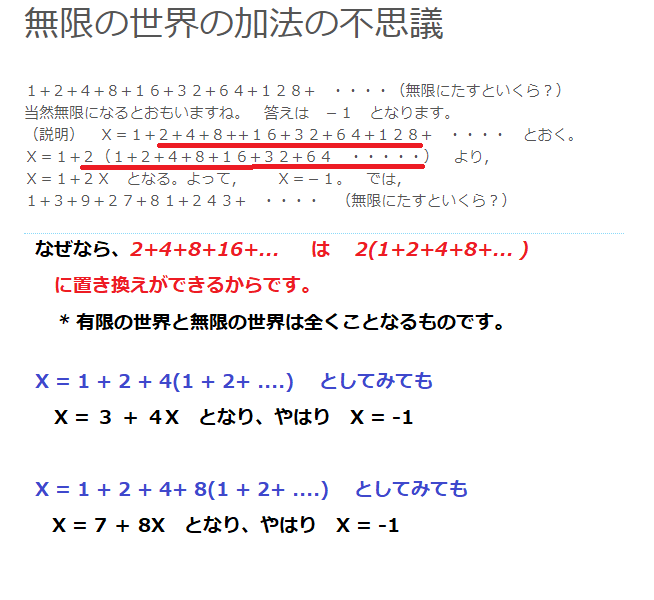
さて(now 今や)我々は一つの関係Pの関係数を、Pに順序的に類似している諸関係の集合と定義する。この定義は、基数の算術(cardinal arithmetic)において、集合の類似性を順序的類似性でおきかえ、かつ集合を関係でおきかえたもの(基数の算術)に相当する(注: cardinal = cardinal number 基数:位取り記数法で数値を書き記す際に各桁の重み付けの基本となる数で、位が上がる毎に何倍になるかを表す。我々が普段使っているのは隣の桁が十倍あるいは十分の一となる十進数)。関係数における加法(加算)、乗法(乗算)、累乗(べき算)(exponentiation)の定義は、基数の算術におけるそれらのものに幾分似たものである。加法及び乗法は両方とも結合の法則に従う。分配の法則は一つの形では成り立つが、一般的に、もう一方の形では成り立たない。交換法則は、関係の範囲が有限である場合以外は成り立たない。たとえば,自然数の系列のような系列に二つの項を加えただけのもの(一つの系列)を考えてみよう。もしその二項を系列の始めに加えるならば、そうしてできた新たな系列はもとの系列に似たものである。しかし、終りに(その2項を)加えるならば、そうではなくなる。二つの関係PとQとの和(関係Pと関係Qの和)は、xがyに対してPなる関係をもつか、あるいはxがyに対してQなる関係を持つか、またはxがPの範囲に属するか、yがQの範囲に属するかである場合に、xとyとの間に成り立つ関係である、と定義される。この定義により、PとQとの和は、一般にQとP(訳注;逆にした場合)との和に相似でないことになる。このことは一般に関係数について真であるばかりでなく、また順序数についても、それらの一方または両方が無限である場合には真である。
Chapter 8 Principia Mathematica: Mathematical Aspects, n.15 We now define the relation-number of a relation P as the class of those relations that are ordinally similar to P. This is exactly analogous to cardinal arithmetic with ordinal similarity substituted for class similarity and relations substituted for classes. The definitions of addition, multiplication and exponentiation are more or less analogous to those in cardinal arithmetic. Both addition and multiplication obey the associative law, and the distributive law holds in one form but, in general, not in another. The commutative law does not hold except when the fields of the relations concerned are finite. For example, take a series which is like the series of natural numbers and add two terms to it. If you add the two terms at the beginning, the new series is like the old one; but, if you add them at the end, it is not. The sum of two relations P and Q is defined as the relation which holds between x and y whenever x has the relation P to y, or x has the relation Q to y, or x belongs to the field of P and y belongs to the field of Q. With this definition the sum of P and Q is not, in general, like the sum of Q and P, This is true not only of relation-numbers in general, but also of ordinal numbers when one or both of these are infinite.
Source: My Philosophical Development, chap. 8:1959.
More info.:https://russell-j.com/beginner/BR_MPD_08-150.HTM
